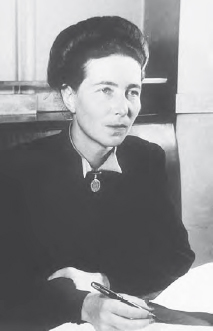Continental PhilosophyJean-Paul Sartre |
Who was Simone de Beauvoir? |
Simone de Beauvoir (1908–1986) is now most famous as the philosopher who began the “Second Wave” of feminism in the West. She began writing when she was eight years old and was a novelist and political writer who helped Jean-Paul Sartre (1905–1980), her main lifelong companion, found Le Monde. De Beauvoir’s major works include the novels She Came to Stay (1943), The Blood of Others (1945), and The Mandarins (1954), and her philosophical texts The Ethics of Ambiguity (1947), The Second Sex (1949), and Old Age (1970). She also wrote evocative autobiographical works, such as Memoirs of a Dutiful Daughter (1958). De Beauvoir ruthlessly described Sartre’s great decline toward the end of his life in Adieu: A Farewell to Sartre (1981).
Beauvoir also quarreled fiercely with Arlette Elkaim, the young Jewish Algerian student who had contacted Sartre when she was 18. Sartre enjoyed discussing his philosophy with Elkaim, and he preferred to write in her apartment, instead of following his lifetime habit of writing in cafés. Then he adopted her and bought her a house in the south of France, which became their summer vacation home.
Beauvoir had an adopted daughter of her own, Sylvie Le Bon de Beauvoir, with whom she had had an erotic relationship, although Sylvie later described it as “platonic.” Sylvie wrote Tête-à-Tête (2005) about de Beauvoir and Sartre.
In 2005, Sylvie and Sartre’s daughter were not on speaking terms. Each in her sixties, they continued to bitterly contest their respective rights to Sartre and de Beauvoir’s literary properties. Since Sartre and de Beauvoir are inextricably linked through letters in which they discussed each other, the complexity of the dispute between their literary heiresses can only be imagined. By 2005, Sylvie was a retired philosophy teacher and Arlette was described as “extremely reclusive.” Geographically, these women had lived close to each other in the same Parisian arrondisement, for some years.
Beauvoir had a high tolerance for alcohol all her life (she liked its “taste”) but drank more heavily in her later years. She was also hooked on amphetamines. When she died in 1986, she was buried in Sartre’s grave, thereby sealing their link for posterity.

